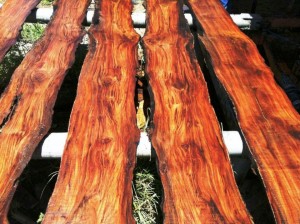Sunken Florida Mahogany. Quite rare, and wonderfully preserved with distinctive streaking.
Common trade names: Cuban Mahogany, West Indian Mahogany, Florida Mahogany
Genus: Swietenia mahogani
Janka Hardness (pounds-force): 1160
Description: Cuban Mahogany has been exported to Europe since the 1500s. The range cited below for Cuban Mahogany does not represent all areas of the earth it is now cultivated. Farms in Asia and Africa may also produce this lumber as a commercial product. It’s a rich brown wood with generally even grain, easier to work than most tropical outdoor hardwoods such as Ipe and Cumaru. Cuban Mahogany is still a generally strong lumber.
Location: Southern Florida, The Bahamas, Cuba, Jamaica, St. Croix, Hispaniola, Virgin Islands.
Common Aliases: Acajou de Cuba, Acajou de Saint Domingue, etc. Bay mahogany, Jamaica Mahogany, etc.
Performance: Easy to work, easy to turn, yet strong and durable enough for a variety of uses. Machines well, and responds nicely to sanding. It’s hard to get a hold of this stuff, as not much is made commercially available, and what is becomes quite expensive!
Acclimation: Give your lumber a couple of weeks time to properly adjust to your local climactic conditions.
Common Uses: One of the historically preferred cabinetry woods. Over-exploitation of Cuban Mahogany has led directly to the restrictions placed upon it today. Cuban Mahogany has become so scarce that Honduran Mahogany is now marketed widely as Genuine Mahogany, as it is a quite close substitute, but they are in fact different. Uses include furniture building, cabinetry, musical instruments, turnings, boatbuilding, fuel wood.
From: The Wood Database
Common Name(s): Cuban Mahogany, West Indies Mahogany
Scientific Name: Swietenia mahogani
Distribution: Southern Florida and the Caribbean
Tree Size: 65 ft (20 m) tall, 3-5 ft (1.0-1.5 m) trunk diameter
Average Dried Weight: 42 lbs/ft3 (670 kg/m3)
Basic Specific Gravity: .56
Hardness: 1,160 lbf (5,150 N)
Rupture Strength: 13,520 lbf/in2 (93,230 kPa)
Elastic Strength: 1,385,000 lbf/in2 (9,550 MPa)
Crushing Strength: 7,090 lbf/in2 (48.9 MPa)
Shrinkage: Radial: 3.7%, Tangential: 4.4%, Volumetric: 6.5%, T/R Ratio: 1.2
